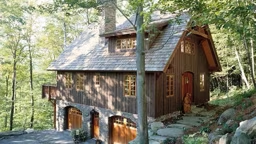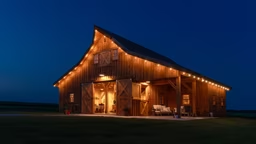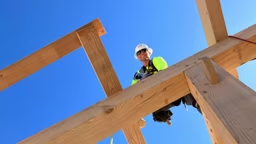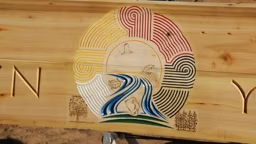In celebration of SepTimber, Timber Home Living is sharing stories from members of the Timber Framers Guild. Learn more about SepTimber here!
By Steve Rundquist, owner of Brewster Timber Frame Company

I’ve been in timber framing since 1980, and this is probably the most satisfying project I’ve ever done. And the story, like the project, is complex. It’s about my relationship with the craft as well as the homeowner— and aren’t most of our timber framing projects about how we see our craft and how we build connections?
For most projects, we start with a blank slate: a design is developed, foundation installed, and the build starts from the ground up. This project was a bit different. The homeowner asked if we could incorporate a timber frame structure into her home’s existing footprint. To complicate things, the home was about 80 years old— you never know what you’re going to find when you start tearing things apart.
The original framing was old full-dimension rough-sawn local pine studs and timbers with rough-sawn 1x board sheathing. We kept the framing and sheathing, added a layer of exterior sheathing to make a smooth exterior plane for siding and trim, then placed a heavy timber beam atop the wall to tie in the new roof system. The new roof system is timber framed with a pine tongue-and-groove roof deck and enclosed with 10.25" SIPs, creating a solid, tightly insulated shell.
But really, this story is about my relationship with the craft of timber framing and the process of ripping a home apart and putting it back together in collaboration with a homeowner who wants to be there every step of the way.

So when I talked with the homeowner, I really heard what she was saying about honoring this home— respecting its soul and the memories and love it held —while remaking it. Through our conversations and the building of trust and understanding between us, it became clear that what we had to build was a home that retained its original character and spirit while drawing in the landscape around it.
The whole structure is surrounded by trees—spruce, aspen, crab apple, ash, elderberry—and they played a role throughout the project as we considered the design, the homeowner’s personality, and even how we would manage the project, since we elected to do all fabrication on the nice, flat 100 acre building site instead of shipping parts and pieces in from the yard.
These trees influenced our build even more than I could have imagined. The spruce softened the corners of the house, helping it fit more comfortably into its space. The elderberry gave the homeowner a sense of connection with her history and her old home in Ohio, and the aspens, native to the west, give her a connection to her present and future in Colorado. Even the crab apple trees helped with the development of the project, offering beautiful spring color as they frame the southerly view.
On this project, we had the opportunity to showcase the richness and variety of the wood we use, each with its own traits, feel, and beauty—and we took full advantage.

chosen with particular care in collaboration with the homeowner. We chose beetle kill pine for interesting custom doors and trim details, white oak for the door thresholds and stair treads, and black walnut for the fireplace surround and mantle. (We used the black walnut to expand a too-narrow screen door as well!)
We also reclaimed barnwood for the cabinets, incorporated woven branches of mountain laurel to create railings inside and out, took advantage of some wormy maple to create an interesting perimeter surround for the interior stairway, and used maple and ash to create window trim corner medallions.
Many times in this business, we are building from the ground up. But occasionally, we find a project that requires us to put our heart into it in a different way, and this was one of those projects for me. I learned what mattered to this homeowner, and it inspired me to consider the kind of heart we all put into this craft we’ve chosen. I’m a carpenter, but more than that, I’m a timber framer. We choose to be timber framers because it’s challenging, interesting work—no two builds are the same, no two timbers are the same, and no two clients are the same. I was reminded of the moments many of us have in this craft, those heartfelt moments when you set the wetting bush; when you come to the end of a long day and step back for a moment to consider your; or when your client sees the frame and the joinery and all the craft that goes into it in the same way you do, with appreciation for the precise way it all fits together.
The day the homeowner told me that the evening before, after getting home from work, she just laid down on the floor and stared up at the intricate timber work of the valleys to main roof connections, trying to work out the purpose of the geometry and how it all went together—that touched me deeply. Even though I’m one of the guys who puts it all together, sometimes I stand back and take a long look and am blown away by what I see and feel.
This experience reminded me that each project and each client is unique. We don’t often have time to slow down and reflect, but I’m grateful for this project that offered me the opportunity to think about the craft, the trees we use, and the people we work with to bring everything together in a finished timber frame.
The trusses on this special home were set by Christmas. After the holiday, we got to work scribing in and setting the valleys and timbers for the intersecting bump out addition roof. Everything fit like a glove. When the final truss was in place we set the whetting bush, thanked the forest for its gifts, and stood back and took a look at what we’d accomplished.
I thought, “The homeowner’s gonna be pleased!”
And she was. Beyond her expectations, she said. And I was thankful for her letting us be a part of her life and this home.

P.s., Want to see more of this home? Check it out here!











